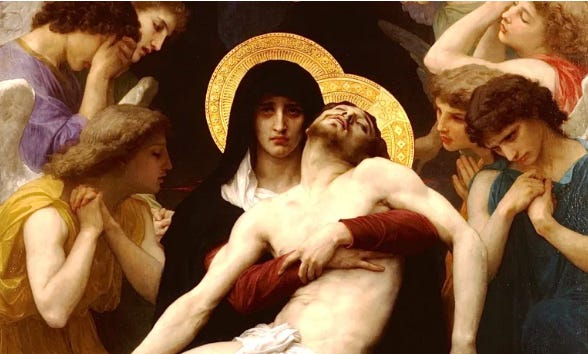Co-Redemptrix Inappropriate? The Post War World in Which Dogma Has Become a Dirty Word
We emerged into a new world after the second world war, a world in which Dogma became a dirty word.
On Tuesday 4th November Mater Populi Fidelis, a Doctrinal Note on Some Marian Titles Regarding Mary’s Cooperation in the Work of Salvation, was issued by the Dicastry for the Doctrine of the Faith, headed by Cardinal Víctor Manuel ‘Tucho’ Fernández.
In it he writes “when an expression requires frequent explanation to maintain the correct meaning, it becomes unhelpful.”
Catholic Professor of Philosophy and arse kicker extraordinaire Ed Feser asks why this point is not applied consistently. He says;
“Consider all the ink spilled in recent years by those attempting to explain how Amoris Laetitia can be reconciled with Christ’s teaching on divorce and St. Paul’s teaching on worthiness to receive Holy Communion. How the revised Catechism’s statement that “the death penalty… is an attack on the inviolability and the dignity of the person” and Dignitas Infinita’s statement that “the death penalty… violates the inalienable dignity of every person, regardless of the circumstances” can be reconciled with the consistent teaching of scripture, the Fathers and Doctors of the Church, and all the popes up to Benedict XVI that the death penalty is not intrinsically wrong. How “blessing couples” in same-sex or adulterous relationships can be licit even though “blessing unions” of those kinds is not. Pope Francis’s claim that “the pluralism and the diversity of religions… are willed by God”. How human beings can “possess an infinite dignity,” given that, on the most natural reading of that expression, only God can have such dignity…”
And Anthony Abbate who is still busy Avoiding Babylon comments;
In order to avoid confusing the Protestants, the Vatican has decided to confuse Catholics instead.
In the 1920’s, Cardinal Mercier of Belgium initiated a petition movement for the papal definition of Mary’s universal mediation, which included the concept of “Co-Redemptrix”. To this end, Pope Benedict XV set up a number of committees which garnered near universal support for the term. That Mary be recognsied as Co-Redemptrix, became the single most petitioned for title, so much so that it was believed Pope Pius XII would declare this a Dogma, but, then came World War II, and having declared the Assumption of Our Lady a dogma in 1950, it seemed Pope Pius XII did not want to declare another Marian dogma during his pontificate, leaving it instead for a successor to do.
However, as argued by Francis Fukuyama in ‘The End of History and the Last Man’, we emerged into a new world after the second world war, a world in which Dogma became a dirty word. Fukuyama argued that history should be viewed as an evolutionary process, and that the end of history, in this sense, meant that liberal democracy was the final form of government for all nations. According to Fukuyama, since the French revolution, liberal democracy had repeatedly proven itself to be a fundamentally better system (ethically, politically, economically) than any of the alternatives.
It is in this post conciliar, post war liberal mileau that we can understand the putative need to issue Mater Populi Fidelis.
100 years ago it was well understood that the husband is head of his wife, and that men have the leading role in society, while the great contribution of women is in nurturing children. If we still had this understanding, then it would not be difficult to understand that the feminine suffix ‘trix’ in Co-Redemptrix shows Mary to be a helpmate to Jesus in the work of our redemption. Mary is not the equal of Jesus, who is our Head. But her role is unique, because Mary fully consented to the offering of her son on the cross as it happened, which nobody else did. Everyone else who has come to the faith did so after the Resurrection.
St. Augustine says that God created us without us, but he did not save us without us. Our redemption involves the act of co-operation. All of this is anticipated in the Old Testament. God deliberately made male and female because, as St. Bonaventure points out in his Breviloquium, human nature is not the same as the Angelic nature. Human nature by the design of God is intended to be mediatory. God creates the visible and the invisible world together, culminating in, as St Bonaventure teaches, the crown of creation, a single unified essence that is both spiritual and material (mater/mother), soul and body, forming one nature.
One of the chief results of the reformation was to break up the unity of Man; body (mater) and spirit (God), lose the sense of our true nature, and the mysterious mediation which is accomplished through it, that which brings together God and matter to become the Word made flesh.




